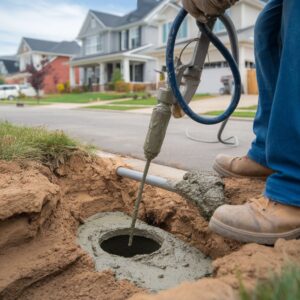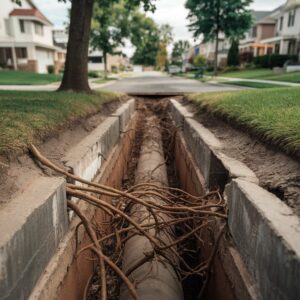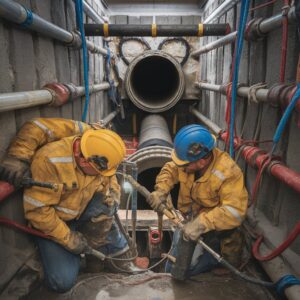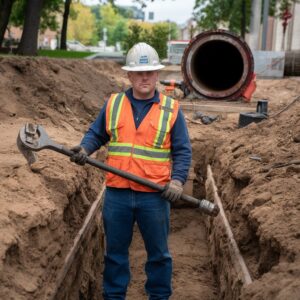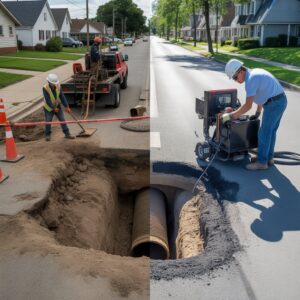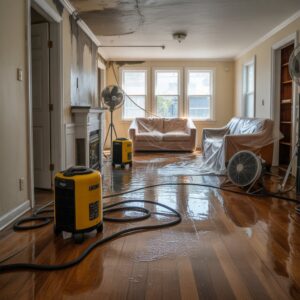It’s easy to ignore sewer lines under your home until problems arise. Knowing when you need sewer line repair or replacement keeps your property safe. In this guide, we explore how to fix common sewer issues. Rely on DNA Plumbing and Heating for expert sewer repair and support every step of the way.
Sewer Lines and Sewer System: Understanding the Basics
Sewer lines keep waste flowing away from your home. They connect to a broader sewer system that treats and disposes of wastewater. If these lines get blocked, several signs of trouble appear. Early detection reduces headaches and lowers costs. Regular maintenance adds years to your sewer lines’ performance and reliability.
Signs of Sewer Line Issues
Warning signals often pop up when your main sewer line has a hidden blockage. Gurgling toilets or slow-moving drains can reveal trouble within the pipes. Unpleasant smells may invade your yard if breaks occur. Sometimes, repeated backups are the most significant signs of sewer line problems. If you notice these symptoms, you might wonder how to repair sewer line mishaps. Some homeowners attempt quick fixes but may only delay the inevitable.
Expert evaluation is vital because a clogged or sagging sewer pipe can worsen over time. If the main line is compromised, you might need professional help from DNA Plumbing and Heating. They can assess the pipe through a detailed inspection and let you know if a repair is enough. When considering how to repair main sewer line sections, plumbers look at the line’s age, location, and overall condition. If the damage is localized, patching might solve it. Larger blockages or offsets could demand a bigger project. Addressing issues early not only restores proper flow but also prevents total failure. Regular checks ensure your home’s plumbing stays safe for the long haul. Stay proactive to avoid expensive emergencies in the future.
Common Sewer Problem to Watch For
One frequent sewer problem is tree root intrusion, where roots crack through the line walls. Once inside, they grow and block normal flow. Another issue is pipe corrosion, often found in older homes with metal piping. Even small leaks cause big trouble over time. Your property may suffer structural damage if wastewater seeps into the surrounding ground. This can lead to uneven floors or even sinkholes. When people try to fix their sewer issues alone, they sometimes use chemical cleaners that damage the pipe further. Professional inspections often reveal hidden bulges or collapsed sections. Such problems can appear without much warning. Observing for slow drainage or unfamiliar odors helps with early detection and may prompt a timely sewer inspection. If an old pipe breaks, you should weigh the best ways to repair it.
In some cases, an upgrade is simpler. DNA Plumbing and Heating uses advanced tools to pinpoint decay or blockages in your sewer or drain line. Regular checks help detect potential hazards before they escalate. No one wants to wake up to a flooded basement or soggy lawn. By identifying problems early, you save time, money, and stress.
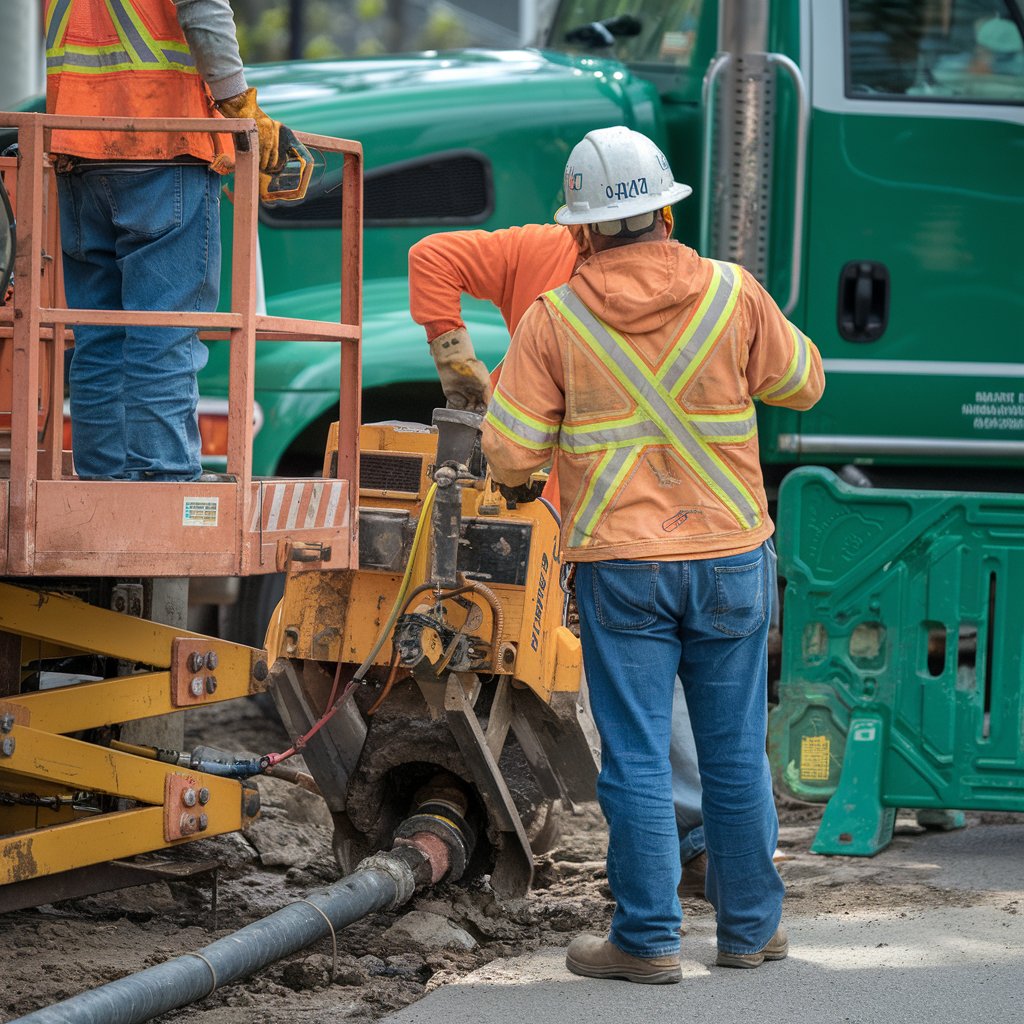
Choosing Between Sewer Line Repair and Full Replacement
Choosing between sewer line replacement and standard pipe repair depends on the extent of damage. Some cases only require localized fixes, while others need a full replacement. Aging lines often face corrosion and leaks. Experts evaluate repair or replacement options carefully. Proper solutions keep your plumbing safe and effective long-term.
When Sewer Line Damage Leads to Sewer Pipe Replacement
Sewer line damage can stem from many causes, like shifting soil or invasive tree roots. Pipe walls may crack, allowing water and waste to escape. When this happens, sewer pipe replacement might be necessary. Technicians often start by making a small access point. They inspect the line’s interior for collapsed segments or heavy blockage.
In some cases, a section of pipe can be fixed without removing the entire length. However, a replacement offers a more reliable fix if the damage spans a large portion. The type of material also matters. Clay or cast iron pipes might require updated solutions. If you find wet spots or persistent foul smells in your yard, these clues often hint that the sewer pipe is compromised. DNA Plumbing and Heating helps homeowners decide on the best route. They use modern techniques, such as video cameras, to see the inside of your sewer lines. By spotting hairline fractures early, you avoid larger problems. Replacing a damaged portion restores normal flow and prevents future occurrences. A strong new line keeps your home’s plumbing efficient. Making the right call early spares you from recurring backups.
Traditional Sewer Line vs Trenchless Sewer Line Repair
Traditional sewer line repair approaches typically involve digging an enormous trench to expose the pipes. This method lets crews remove old or broken sections by hand. However, open-trench work can harm landscaping and require extra labor. Trenchless sewer line repair offers an alternative. With this technique, workers access the pipe through minor entry points, making far less disturbance to your yard or driveway. Sometimes called slip-lining or pipe bursting, trenchless methods use modern materials that fit inside the old line or replace it entirely. This approach often causes fewer disruptions and can be completed faster.
While traditional sewer line excavation remains effective for some severe cases, trenchless repair is a more appealing option for many homeowners. You may save on restoration costs for your lawn, trees, or walkways. A skilled contractor inspects the pipe’s condition to decide which technique works best. The old-operation might still be necessary if the line is severely collapsed. Yet if the interior damage is moderate, a no-dig approach spares you unnecessary hassle. DNA Plumbing and Heating can guide you on the correct repair path. Both methods aim to restore flow and prevent future breaks.
Professional Sewer Line Repair and Replacement: How to Fix Your Sewer
Sometimes sewer line repair alone isn’t enough. If backups recur, it might be time to fix your sewer. Professional sewer line repair and replacement include thorough inspections, advanced techniques, and specialized equipment. Knowing how to repair sewer line trouble helps. Proper care prevents property damage and supports healthy home living.
Handling a Sewer Line Break
A sewer line break can bring sudden chaos. The first step is to shut off water sources to prevent further flooding. Next, call experts who can evaluate the break location.
| Potential Cause | Suggested Action |
|---|---|
| Sagging pipe | Elevate or replace section |
| Tree root invasion | Cut roots and seal pipe |
| Line collapse | Excavate or reline as needed |
Sometimes you may see water pooling in the yard or hear strange gurgling in the drains. Skilled plumbers use specialized cameras to spot the break quickly. They will also check if the pipe is partially or completely severed. Once they know how to repair sewer line break points, they choose the best strategy. Certain breaks might be sealed with patching compounds if the damage is minor, while bigger fractures need thorough excavation or trenchless methods. You could face extra cleanup and sanitation tasks if sewage spreads beneath your home. DNA Plumbing and Heating can help manage such crises. The experts ensure the area is disinfected and safe.
Additionally, they work with you to plan a long-term fix. After repairing the line, they test the water flow to confirm everything is back to normal. Remember, ignoring a break can lead to severe structural damage over time. Acting fast keeps your home free from dangerous germs and foul smells. Protect your family now.
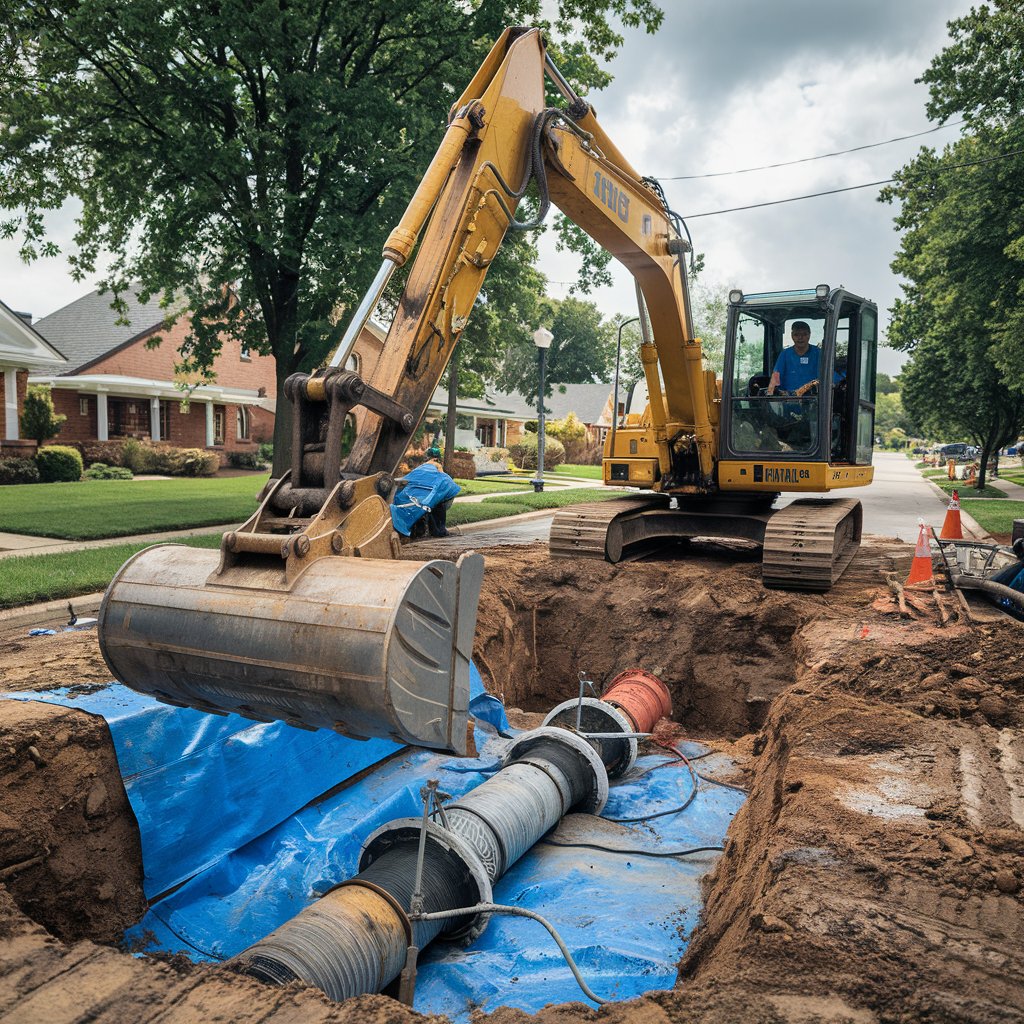
How to Repair a Broken Sewer Line Quickly
When you have the right tools, figuring out how to repair a broken sewer line is simpler. First, locate the troubled spot by monitoring all your drains. The break is likely near the main line if multiple fixtures are backed up. Shut off water use in and around the house to stop further overflow. Next, consult a plumbing specialist who can recommend the best approach, such as trenchless repair or partial pipe replacement. They may also suggest a temporary fix if extensive excavation is needed. Sometimes, a minor crack can be sealed internally through advanced epoxy. For bigger breaks, however, digging might be unavoidable.
DNA Plumbing and Heating offers complete evaluations before finalizing plans. They consider your pipe’s age, soil conditions, and your budget. Quick action is vital because letting the damage linger could worsen the break. Sewage might seep into the ground, making repairs more expensive. Understanding how to repair a sewer line effectively protects your household from contamination. After the line is patched, plumbers often conduct final tests to ensure smooth flow. Proper repairs preserve your plumbing system and give you peace of mind. Act swiftly always.
Complete Solutions for Sewer Line Repair and Upkeep
Sewer repair and replacement services handle everything from clogs to major collapses. You get inspections, professional repairs, and ongoing maintenance with proper sewer line services. They also cover preventative measures, like regular cleanings and camera checks. Trustworthy teams like DNA Plumbing and Heating keep these vital systems functioning well.
Complete Sewer Line Inspection and Plumbing Guidance
Many homeowners overlook the importance of a complete sewer line inspection until an issue arises. A thorough check involves running a specialized camera through the pipe to detect cracks or obstructions. This process is more straightforward than guessing where problems might lie. Technicians also examine connections to ensure each joint is sealed. If any shift in the soil has dislodged the pipe, they spot it fast. During an inspection, you get practical guidance about maintaining your lines effectively.
That might mean scheduling routine cleanings or being careful with what goes down the drains. Even minor items, like wipes or grease, can cause buildup. You stay ahead of potential disasters by inspecting your system once a year. DNA Plumbing and Heating can offer advice that suits your home’s layout and the material of your pipes. If corrosion is spotted, you have time to fix it before a complete blockage occurs. An inspection also reveals if tree roots have started to intrude or if the slope of the piping has changed. Early insights help avoid expensive repairs. In the long run, you preserve your property and wallet and prevent future breakdowns.
Sewer or Drain Line Service for Any Repair Cost
Watching your budget is essential when considering sewer or drain line work. The repair cost can vary widely, depending on how deep your pipe sits or how extensive the damage is. A simple blockage might cost much less than a collapsed line requiring major excavation. Sewer or drain line service companies often provide up-front quotes so you know what to expect. Ask if extra fees apply for emergency visits, especially if a pipe fails at night or on weekends. Professional teams, like DNA Plumbing and Heating, detail each expense, from initial inspection to final restoration. If you worry about the total bill, you can consider financing options or phased repairs. Sometimes, partial fixes are stepped out over time. Regardless of repair cost, prompt action is essential. Delaying a damaged line could lead to wastewater backups or contamination.
Sometimes, the city might also fine you if your broken pipe endangers nearby properties—particularly in areas with combined sewer systems that impact public drainage. Keep communication open with your contractor to understand each step of the process. This way, you can plan your budget carefully. Quality repairs restore your home’s sewer lines without hidden financial surprises. Trust skilled experts always.
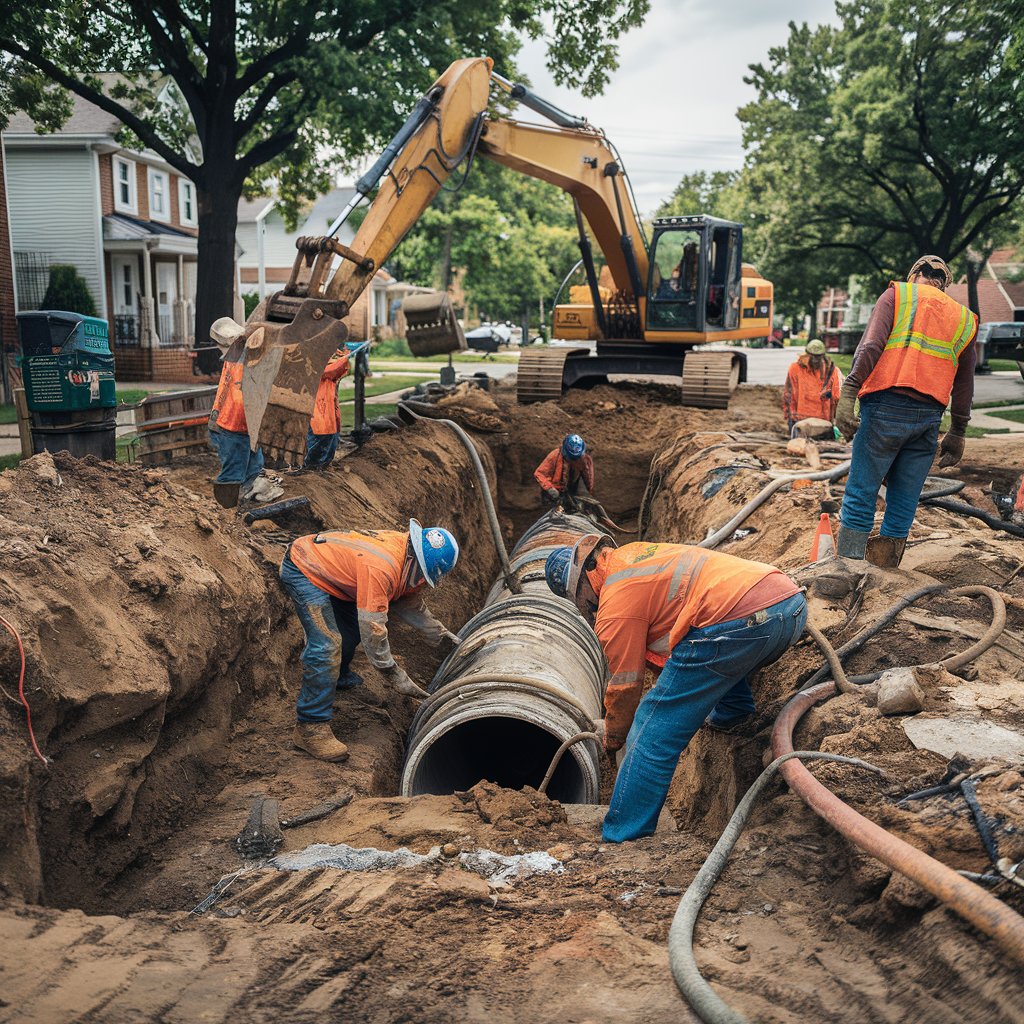
Conclusion
Knowing how to repair a sewer line or decide on sewer line replacement prevents disasters. Whether you need traditional digging or trenchless methods, the right move protects your home and finances. Regular sewer line inspection and timely fixes keep everything running. Depend on DNA Plumbing and Heating for effective and innovative services.

